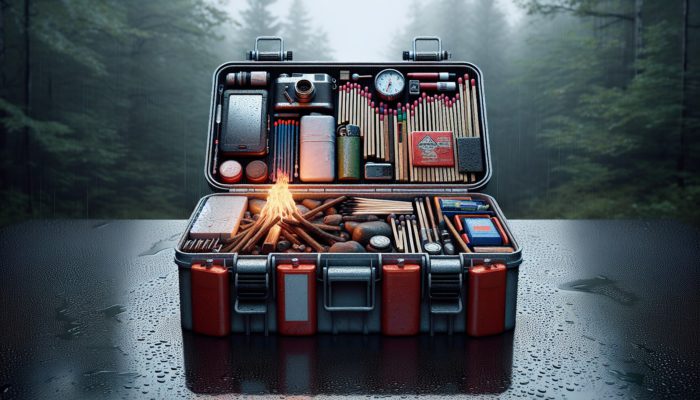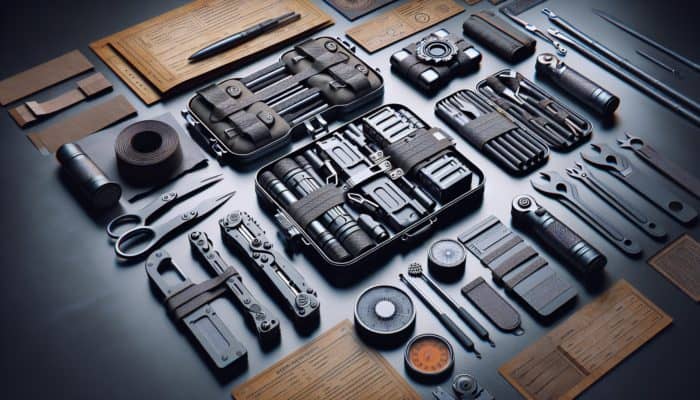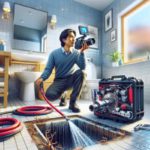Uncover the Vital Role of Fire-Starting Kits in Ensuring Outdoor Safety
Recognising the Indispensable Function of Fire in Survival Situations

The importance of fire in survival scenarios is profound, serving as a vital lifeline that offers warmth, facilitates cooking, and enables the purification of water. In particularly harsh wilderness locales, such as the Amazon Rainforest or the Sahara Desert, the ability to create a fire can be the deciding factor between life and death. Fire combats the chilling cold of night, providing not only physical warmth but also crucial psychological comfort, which fosters a sense of security and normalcy amidst potentially overwhelming situations. Studies have shown that the presence of fire can significantly reduce stress levels, enhancing feelings of community and safety among those gathered around its glow. Furthermore, cooking over an open flame can mitigate the risk of foodborne illnesses, while also assisting with digestion and improving nutrient absorption. Therefore, mastering the skill of fire-making is an essential capability for anyone embarking on outdoor excursions.
Key Items to Include in Your Fire-Starting Kit for Maximum Effectiveness
When confronting challenging outdoor conditions, possessing a dependable fire-starting kit is paramount. Essential items encompass waterproof matches, which guarantee that you can ignite a flame even in damp atmospheres. A windproof lighter is also vital, as it produces a consistent flame irrespective of adverse weather conditions. Additionally, fire starters like tinder—which can be derived from natural materials such as dry leaves or can be purchased as pre-made options—are crucial for establishing a fire swiftly. A ferro rod is particularly invaluable for those who prefer a rugged approach, generating intense sparks when scraped against steel. Each of these components is significant in ensuring that a fire can be ignited under a multitude of circumstances, whether you are traversing a humid jungle or a parched desert landscape, thus enhancing your overall survival strategy.
What Key Factors Should You Take into Account When Selecting a Fire-Starting Kit?
When determining which fire-starting kit is most suitable for your needs, it is essential to carefully assess your specific requirements, factoring in the environment and activities you intend to pursue. If your adventure takes you into wet regions, opting for waterproof matches and a robust lighter is advisable. Conversely, for arid conditions, a compact kit featuring tinder and ferro rods may suffice. Reliability is of utmost importance, so conducting comprehensive research and reading user reviews can significantly enhance your selection process. Ease of use is another crucial consideration, especially for novices. A kit that includes clear instructions or supplementary resources—such as an instructional booklet or video links—can prove invaluable. Always prioritise kits that have undergone rigorous testing in real-world scenarios, as these provide assurances of effectiveness in emergencies.
How to Ensure Your Fire-Starting Kit Remains in Optimal Condition

To guarantee that your fire-starting kit is always ready for action, regular maintenance is crucial. Frequently inspect your matches and lighters; replace them immediately if they appear worn or depleted. It is advisable to store your kit in a waterproof container to shield it from moisture, which can compromise even the most reliable fire-starting tools. Cleaning and thoroughly drying components after use, particularly in damp conditions, will significantly prolong their lifespan. Maintaining an organised kit not only saves precious time during emergencies but also ensures that all essential items are easily accessible. Regularly reassessing your kit allows for the integration of new technologies or supplies that can enhance your fire-starting capabilities, keeping you well-prepared for any outdoor scenario.
Essential Techniques to Improve Your Fire-Starting Skills
Continual practice with your fire-starting kit is vital for honing your skills effectively. Familiarise yourself with various methods of igniting a fire under different environmental conditions, such as using dry leaves in a forest or pine needles in mountainous terrains. Create practice scenarios that replicate real-life conditions, such as windy weather or rainy situations, to better prepare yourself. Understanding how to gather and prepare tinder, kindling, and larger fuel sources will enhance your confidence and efficiency when the need arises to start a fire during emergencies. Engaging in fire-starting drills not only sharpens your technical skills but also significantly enriches your overall survival knowledge, transforming you into a more competent adventurer in the wild.
Expert Insights on the Best Fire-Starting Kits
What Characteristics Are Essential in a Reliable Fire-Starting Kit?

Several key factors set apart a dependable fire-starting kit from the rest. First and foremost, durability is essential; kits made from high-quality materials are designed to endure harsh environmental conditions. Secondly, ease of use is crucial; a well-constructed kit should enable anyone, regardless of their experience level, to ignite a fire swiftly and efficiently. Thirdly, versatility is vital; a quality kit must perform effectively in a diverse range of scenarios, whether in wet, dry, or windy environments. Fourthly, the Weight and portability of the kit are significant considerations for hikers or campers who value a lightweight pack. Examples of reliable kits include the UST Strikeforce Fire Starter, renowned for its compact design and performance in all weather conditions, and the Exotac nanoSTRIKER, celebrated for its durable construction and lightweight nature.
- Durability of materials used
- Ease of use under various conditions
- Versatility for different environments
- Weight and portability
- Availability of multiple ignition methods
- User reviews and real-world testing
- Waterproof or weather-resistant storage
- Comprehensive instructional materials
What Best Practices Should You Implement for Maintaining Your Fire-Starting Kit?
Regular upkeep of your fire-starting kit is vital for ensuring its preparedness for emergencies. Start by cleaning and thoroughly drying each component after use, especially if it has been exposed to moisture. Periodically inspect your kit and replace any used or expired items, such as matches or tinder that may have diminished in effectiveness. Store your kit in a waterproof container to protect it from unwanted moisture. Additionally, it is beneficial to practice using your kit consistently; this not only confirms that all components function correctly but also helps you become more acquainted with the nuances of each tool. Creating a maintenance checklist can streamline this process, ensuring that no vital elements are overlooked.
What Recent Innovations Are Revolutionising Fire-Starting Kits?
The realm of fire-starting kits has experienced exciting innovations aimed at improving usability and reliability. For instance, solar-powered lighters harness sunlight to create flames, offering an eco-friendly alternative to traditional lighters. Furthermore, reusable plasma lighters have emerged, generating a windproof and waterproof flame, making them ideal for challenging environments. Compact, all-in-one kits are gaining traction, designed to fit seamlessly into outdoor gear without consuming excessive space. These advancements reflect a growing trend towards making fire-starting more accessible, efficient, and reliable, catering to both seasoned adventurers and novices alike. Exploring these innovations can significantly enhance your outdoor experience, ensuring you remain equipped regardless of the weather conditions you encounter.
Mastering the Effective Utilisation of Fire-Starting Kits
A Step-by-Step Guide to Successfully Igniting a Fire
Starting a fire involves several straightforward steps that, if followed attentively, yield successful outcomes. Begin by preparing your fire site, ensuring it is free of debris and located a safe distance from flammable materials. Next, gather your tinder, kindling, and larger fuel, arranging them in a manner that promotes airflow. Once your materials are assembled, use your fire starter to ignite the tinder. It is advisable to light the tinder at multiple points to encourage an even burn.
- Choose a safe, clear site for your fire
- Gather tinder, kindling, and larger fuel
- Arrange materials to allow for airflow
- Use a fire starter to ignite the tinder at multiple points
- Gradually add kindling as the fire expands
- Monitor the fire, adjusting materials as necessary
- Practice extinguishing techniques to ensure safety
- Always have a backup fire starter ready
Successfully establishing a fire necessitates patience and practice. Tailor your approach based on the materials available and the environment you find yourself in; for example, in a forest, you might use dry leaves, while at the beach, driftwood could serve as your best option.
What Fire-Starting Techniques Are Most Effective for Different Environments?
Different environments require specialised fire-starting techniques to ensure success. In a forest setting, you may encounter abundant dry leaves and twigs that serve as excellent tinder. Seek sheltered areas to minimise wind interference. On the other hand, coastal regions may offer driftwood as a reliable fuel source, though ensuring its dryness requires diligence.
In frigid environments, look for dry bark or resinous wood, which burns hotter and can ignite even in damp conditions. Acquiring a comprehensive understanding of your surroundings enables you to adjust your fire-starting techniques accordingly, ensuring that you have the necessary materials readily available. Furthermore, consider local conditions such as altitude or humidity, which may influence fire behaviour.
What Common Mistakes Should You Avoid When Starting a Fire?
Starting a fire may appear deceptively simple, yet numerous common mistakes can hinder your success. Firstly, using damp materials is a frequent error; always ensure that your tinder and kindling are dry. Overcrowding your fire can stifle airflow, obstructing proper combustion, so arrange your materials to allow for adequate ventilation. Additionally, neglecting to have a backup fire starter can lead to frustration if your primary method fails. Lastly, failing to assess local fire regulations or conditions can pose risks to both yourself and the environment, potentially resulting in legal repercussions or wildfires. Recognising and evading these pitfalls will significantly enhance your fire-starting capabilities.
Investigating Various Options for Fire-Starting Kits
What Features Define Traditional Fire-Starting Kits?
Traditional fire-starting kits generally consist of familiar tools such as matches, lighters, and natural tinder like dry leaves or wood shavings. These kits are often favoured for their simplicity and user-friendliness. Matches are particularly effective in calm conditions and are readily accessible, while lighters offer enhanced reliability across a range of weather conditions. Utilising natural tinder promotes environmental sustainability, fostering a connection with nature. Many outdoor enthusiasts gravitate towards traditional kits due to their affordability and straightforwardness, making them a popular choice for casual campers and hikers alike.
What Innovative Features Are Present in Modern Fire-Starting Kits?
Contemporary fire-starting kits have revolutionised our approach to igniting flames in the great outdoors. These kits frequently incorporate advanced tools, such as ferrocerium rods that generate intense sparks when scraped, magnesium blocks that can ignite quickly, and chemical fire starters designed for rapid ignition. Such innovations cater to those who require efficiency and reliability, particularly in adverse conditions. The compact design of many modern kits makes them easy to transport, ensuring they fit seamlessly into any backpack or survival gear. Their enhanced functionality can be crucial, especially when time is of the essence, such as during emergencies or extreme weather conditions.
Comparative Advantages of Traditional vs. Modern Fire-Starting Kits
Traditional fire-starting kits offer several advantages, including affordability and familiarity, making them accessible even to novice campers. They require minimal instruction and are often readily available in local stores or online. In contrast, modern fire-starting kits provide greater reliability, particularly in challenging environments. Their innovative components are specifically engineered to withstand adverse weather, ensuring that a fire can be ignited when most needed. Ultimately, the decision between traditional and modern kits hinges on individual preferences, environmental factors, and the specific scenarios in which they will be employed.
Research-Backed Advantages of Fire-Starting Kits
How Do Fire-Starting Kits Contribute to Enhanced Survival Rates?
Fire-starting kits play a pivotal role in increasing survival rates during emergencies. They empower individuals to generate warmth, prepare food, and purify water, all of which are vital for survival. In situations where individuals may find themselves stranded, the ability to start a fire can significantly boost mental well-being and morale, which are essential for sound decision-making. To optimise their effectiveness, it is advisable to familiarise yourself with various fire-starting methods and practice under differing conditions to enhance your confidence. Moreover, understanding how to maintain and effectively utilise your kit can save invaluable time and resources when every moment is critical.
What Psychological Benefits Does Fire Offer in Survival Situations?
The presence of fire provides considerable psychological benefits, particularly in survival scenarios. Fire creates a sense of security and comfort, alleviating feelings of stress and anxiety. Individuals gathered around a fire often experience a heightened sense of community and companionship, which is vital for morale during survival situations. This calming effect aids in clearing the mind, facilitating better decision-making, and enhancing focus on essential tasks. The warmth and illumination of a fire create an inviting atmosphere, promoting relaxation even amid adversity. Recognising these psychological advantages underscores the importance of fire-making skills during outdoor excursions.
How Do Fire-Starting Kits Enhance Safety While Outdoors?
Fire-starting kits are invaluable tools for promoting safety across various outdoor environments. Controlled fires can serve as signals for assistance, providing visibility during emergencies or aiding in search and rescue operations. Furthermore, fire can act as a deterrent to wildlife, keeping dangerous animals at bay while offering warmth during cold nights. Understanding how to utilise a fire-starting kit properly enhances your ability to manage fire safely and effectively. By having a reliable kit on hand, outdoor enthusiasts can reap the benefits of fire while mitigating potential hazards, such as uncontrolled wildfires. This balance between utility and safety is essential for all adventurers.
How Do Fire-Starting Kits Improve Cooking Efficiency?
Fire-starting kits substantially enhance cooking efficiency in survival situations. The ability to ignite a fire quickly and reliably allows for immediate food preparation, conserving valuable resources such as time and energy. When you can effortlessly start a fire, you are more likely to prepare nutritious meals that promote health and uplift morale. Additionally, proficient fire use facilitates proper cooking techniques, such as boiling water for purification or roasting food to enhance both flavours and nutrient content. Understanding the intricacies of fire-starting can streamline cooking processes, enabling you to sustain yourself in challenging environments without unnecessary stress.
Best Practices to Ensure Fire Safety in Outdoor Settings
How to Properly Extinguish a Fire Safely
Safely extinguishing a fire is imperative to prevent wildfires or injuries. Always ensure that the fire is completely extinguished by dousing it with water, stirring the ashes, and checking for residual heat. After extinguishing, use your hands or a stick to feel for warmth in the ashes.
- Utilise water to thoroughly douse the fire
- Stir the ashes with a stick to mix and expose hot spots
- Check for heat with your hands from a safe distance
- Use dirt or sand if water is unavailable
- Leave the site clean and free from debris
- Inform others of your fire extinguishing practices
- Adhere to local regulations regarding fire extinguishing
- Always have a fire extinguisher at hand if available
Implementing these practices ensures that your fire is fully extinguished and mitigates the risk of accidental fires reigniting.
What Is the Critical Importance of Fire Containment?
Effective fire containment is crucial in preventing the spread of flames, which can threaten both human life and the surrounding environment. Understanding how to create a secure fire ring or pit can protect vital ecosystems and avert wildfires. Always select a fire site a safe distance from flammable materials and consider utilising rocks to contain the fire. In high-risk areas, having a fire containment plan is essential; being aware of local regulations regarding open flames helps maintain safety. Adopting best practices for fire containment is not just responsible but also vital for the preservation of nature.
What Legal Considerations Should You Keep in Mind Regarding Fire-Starting?
Understanding the legal considerations associated with fire-starting is paramount for outdoor enthusiasts. Many regions enforce specific regulations concerning open flames, particularly during dry seasons when wildfire risks are heightened. It is crucial to check local laws and, if necessary, obtain the required permits before igniting a fire. Additionally, respecting designated fire zones and adhering to fire bans can prevent legal repercussions and environmental damage. Being informed about fire regulations ensures that your adventures remain safe and compliant with local laws, enabling you to enjoy the outdoors responsibly.
Proven Strategies for Assembling Effective Fire-Starting Kits
How to Create a Comprehensive Fire-Starting Kit
Building a comprehensive fire-starting kit requires meticulously selecting various tools and methods that ensure reliability across a range of conditions. Include traditional items such as waterproof matches and lighters, alongside modern options like ferro rods and magnesium blocks. Incorporating multiple types of tinder—both natural and synthetic—can greatly enhance your chances of success. Additionally, consider including tools for fire maintenance, such as a small shovel or fireproof gloves. This diversity not only prepares you for unexpected challenges but also equips you to adapt to changing conditions, ensuring you possess the right tool for the job at hand.
What Are Practical Tips for Transporting Fire-Starting Kits?
When transporting a fire-starting kit, prioritising accessibility and protection is essential. Choose a dedicated pouch or container that can withstand the elements, ensuring that your components remain dry and in optimal condition. Keep the kit easily accessible within your backpack, avoiding deep compartments where it may be challenging to retrieve in an emergency. Regularly inspect your kit’s contents before each trip to ensure everything is operational and adequately stocked. Understanding how to organise your kit effectively will make a significant difference when you need to start a fire promptly.
What Are the Best Practices for Fire-Starting Training?
Engaging in consistent fire-starting training is crucial for ensuring proficiency in practical scenarios. Allocate time to practice with your kit under various environmental conditions, simulating real-life challenges. Incorporate both traditional and modern techniques to expand your skill set, enabling you to adapt swiftly to any situation. Joining local outdoor clubs or survival workshops can provide valuable insights and practical experience, further enhancing your abilities. Documenting your practice sessions, including both successes and challenges, will create a valuable resource for future reference and skill improvement.
Frequently Asked Questions
What essential items should I include in my fire-starting kit?
A comprehensive fire-starting kit should consist of waterproof matches, a windproof lighter, natural tinder, a ferro rod, and potentially a magnesium block for quick ignition.
How can I successfully start a fire in wet conditions?
To ignite a fire in wet conditions, gather dry tinder and kindling from sheltered areas, utilise a reliable fire starter, and create a windbreak to safeguard the flame.
How frequently should I inspect my fire-starting kit?
It is advisable to check your fire-starting kit before each outdoor trip, replacing any used or expired items to ensure everything remains in good working order.
Can household items be used as fire starters?
Household items like dryer lint, paper, and even egg cartons can serve as effective fire starters when paired with suitable tinder.
Why is it important to have a backup fire starter?
Having a backup fire starter is essential in case your primary method fails. Access to alternatives ensures you can still ignite a fire when necessary.
Which materials should I avoid using as tinder?
Avoid using damp materials, plastics, or treated wood as tinder, as they can release harmful fumes and impede fire ignition.
How can I practice fire-starting safely?
Practice fire-starting in a controlled environment, away from flammable materials, and always keep water or another extinguishing agent readily available.
Are there specific fire regulations I should be aware of?
Yes, regulations differ by location; always verify local laws regarding fire use, particularly during dry seasons or in designated areas.
How does fire improve morale during outdoor adventures?
Fire provides warmth, illumination, and a gathering place, fostering a sense of community and security among individuals in outdoor settings.
What is the proper method for extinguishing a campfire?
To extinguish a campfire, thoroughly douse it with water, stir the ashes, and ensure no embers remain hot before vacating the site.
Discover our adventures on X!
The post Fire-Starting Kits: Essential Gear for Survival appeared first on Survival Bite.
The Article Fire-Starting Kits: Must-Have Survival Gear Was Found On https://limitsofstrategy.com

